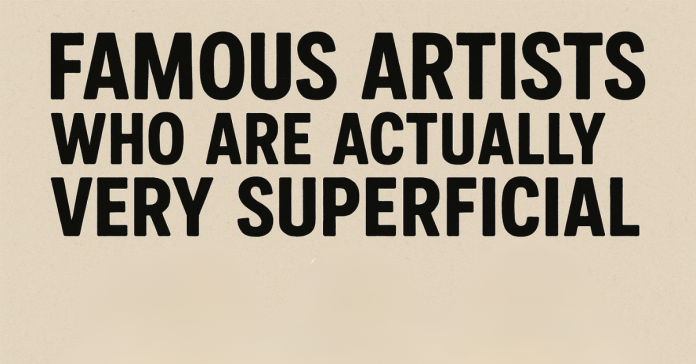(all focus on money and getting rich, thats called superficial). No giving back or other dreams or goals.
Admittedly, the entertainment industry is a shimmering world in which not everything that glisters is gold. Where some musicians in today’s world are occupied with making real changes, others prefer their wallets and Instagram stories. Today we’re going to be exploring the topic that is not very well-developed artists? Honestly, spare me the hate—check-in here simply provides some hot and honest takes.
Style Over Substance: The Instagram Illusion
In today’s society, image is the key to success and it is rather hard to deny it. However, some of the artists are known to exaggerate such portrayals to a level of creating a highly polished alter ego atmosphere that resembles an art gallery. Take Kim Kardashian for instance, she is technically an artist nowadays (one has to argue that being a personality of a reality show is also a form of art). Although she cannot be accused of not knowing how to accumulate her riches, her impact is solely based on selfies, products, and controversies. Her art? The art of being famous.
When was the last time you found yourself pondering over something more than the latest shading and highlighting tip Kim K has shared? The woman’s attempts at prison reform advocacy sometimes even come across as manufactured publicity stunts and not genuine interest. First, it is crucial to note that the woman under review is a marketing mastermind, although the topic does not provide much information about her depth. That’s not really her brand.
The Money Machine: Artists Who Chase Dollars, Not Dreams
Cardi B has rapped since her arrival and her talent and energy cannot be questioned, however her main concern appears to always be about the Benjamins. “I’m just a regular degular shmegular girl from the Bronx” she said this and today, it is all about Birkin bags, diamond and everything that has to do with having money to parade.
Money over talent and being inspiring.
Here thematically she does not go farther than materialism, sex, and throwing shades at her detractors. Though there is nothing intrinsically wrong with enjoying prosperity, it has caused her to become obsessed with money; thus reducing her artistic performances to mere £75. Then, what happened to the usage of this platform for something other than merely flaunting the latest shopping trip?
The Beyoncé Paradox: Performative Wokeness?
Please forgive me for what I am going to say next, especially to the Beyonce fanatics out there – the Beyhive. Beyoncé is talented, extremely talented, there can be no doubt about that. Below the rousing songs about women’s independence and creative extravaganza, there is something that at times appears… forced.
Her exterior appearance is very distant and she does not shed her armour often. There appears to be a deliberate attempt to choreograph every action and choose the right words that will not cause further offense. But even her albums that are her most ‘personal’ experience of music are so packaged and polished from beginning to end that they are as much products as the perfect image implies.
It would, however, only be wise to note that anytime she embraces a social cause it is always so perfectly timed with album releases. The album’s lead single “Formation” is remembered to have been released in preparation for the Super Bowl performance and tour announcement. Perfect timing for maximum publicity. They ponder whether she is using social problems to market her albums or on the other hand whether she is using the albums to market social problems. The line gets blurry.
Nicki Minaj: Talented But Trapped
This is because early in Nicki Minaj’s career, the lady demonstrated a world of potential. Her other personalities, fast-paced machine-gun delivery, and a knack for crossing all genres indicated that she had something that is rare and that is vision. But somewhere in the between the substance has been washed down with controversies, drama, and even more, meaningless lyrics.
In recent years, she has much more registered, twitter tantrums and feuds, rather than genuinely gradual transformation and growth as a performer. It is tuned that when she does open her mouth on any issues, then she adopts a defensive or selfish tonality rather than a constructive one. The woman, who could once run a lyrical ring around the rest of the industry’s competitors, looks more interested in making waves than making art that’s important.
Can you recall when she began an unnecessary rant against vaccinations during a pandemic? Not doing much with it in terms of responsibility. This has always been a somewhat baffling oversight for someone with such influence and talent; to engage in petty battles and self-aggrandizement.
The Counter-Examples: Artists With Actual Depth
The hope is not lost yet in the music industry Despite some of the worst feelings that people have looked out for in this industry, it is clear that the situation is not hopeless. Alicia Keys and other artists have proven that one can achieve success yet still work for what he/ she believes in commercially. Keys has been provided solutions to these social issues, realistic natural beauty as opposed to the synthetic beauty practiced by most singers of today and having music that encourages emotional connection.
Though she may not grace the cover magazines at the moment, Christina Milian has been quite consistent and true to the game. Megan Hausern is a mother of two wonderful children and she is also an entrepreneur and artist, but her fans still feel the connection.
Not even Rihanna, a lady who certainly knows what it is like to live a lavish life, has gone to creating a beauty company that is for all forms of skin complexions but this she has used her influence to fund education and disaster relief around the world. This is the best way to make use of one’s success in something productive.
Why Does This Matter?
In a world where artists play such a huge role, particularly in shaping the youthful population’s orientation, values cannot be taken lightly. When music’s biggest and most admired icons have nothing but possessions, appearance, and muscle as their common currency to tout and boast about, it says a lot about what is valued in today’s society’s mainstream image.
It is a great disservice on their part that those artists who wade on the images, money, and insignificant rivalries content themselves with creating pieces that lack substance. They are doing that to themselves and to their clients or viewers as well.
Art was never more than fun; it was a mirror, communication, change. It is not only artists’ talent cuts their life expectancies short, but more so they perpetuate the culture that celebrates appearance rather than reality.
The Bottom Line
Now, I do not mean that these artists should turn into philosophers or activists over the night. Party or glamorous pictorial songs or shots do not hurt anyone now and then. However, time moves on and such great writers and musicians provide something more profound along with the fun and laughter.
The question that has emerged for today’s stars is rather banal: having changed fashion and counted money, what have the artists added to the enrichment of people? Will the extermination of Sheen be blamed on substance or style?
If it is the easy way that will make an artist famous and financially well off in the shortest time possible, then that is quite shallow creativity as opposed to artists who create a rich foundation. Deception could very well be one product of the post-industrial society that remains irreplaceable, and a reflection of the culture consumers are headed towards.

